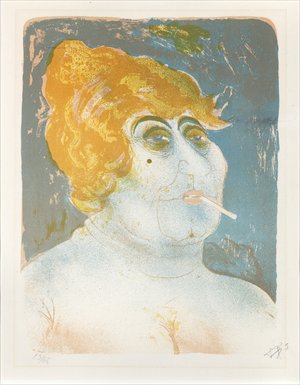Goodbye to all that
When World War I broke out in Europe in 1914, a German artist called Otto Dix (1891-1969) signed up to fight with barely a second thought.
The decision was driven neither by nationalism, nor by political ideology; rather it was motivated by the sheer desire to have an unusual experience.
As Dix would comment later in life, the decision had been a must for him as a pure realist, to see what war was like with his own eyes.

On the frontlines
Between 1915 and 1918, Dix served as a non-commissioned officer in a machine-gun unit traveling back and forth between the frontlines of the Western and Eastern fronts, during which time he attained the rank of sergeant. More notably, he created more than 600 drawings and watercolors depicting scenes from the war.
The worldwide conflict ended in 1918, but the ex-soldier's efforts to rid himself of the nightmares of that time were just beginning. Dix later said that for the next decade he was haunted by dreams in which he was trapped in the ruins of a battlefield, and even painting couldn't help him out of this misery.
Based on his personal wartime experiences, Dix created a series of 50 bronze etchings simply called The War which he worked on between the autumn of 1923 and the spring of 1924 and which were shown to the public later that year.
"For Dix, etchings were a more direct and effective way to describe the calamity of war than paintings could have been," said Werner Meyer, the art historian and curator of the Kunsthalle Göppingen art gallery in Baden-Württemberg, Germany. Meyer was invited to speak at the opening ceremony of an exhibition featuring Dix's etchings in the city last week.
The Zendai Contemporary Art Space in Yangpu district is playing host to some 86 etchings by Dix, most of them created in the 1920s. The show lasts until the end of this month and Shanghai is the second stop on a nationwide tour, initiated by the German-based Institut für Auslandsbeziehungen (Institute for Foreign Cultural Relations, IFA) and which also takes in Nanjing, Chongqing and Guangzhou.

Battle-weary
Audiences can see images as varied as battlefields drenched with corpses, battle-weary troops retreating from the Battle of Somme, and a blind armless veteran selling matches on the street.
The War made Dix a pioneer of his kind in art history, following in the footsteps of Goya (1746-1828), the Spanish artist who created a similar series of aquatint prints called The Disasters of War based on the Peninsular War (1808-14).
"Both of the artists used techniques of the 'grotesque' to describe something very strong in their works," said Meyer. "The two series of works have the same spirit; that is the artists depicted the cruelty of war based on their experiences. Through Otto Dix's works, created over a long period of time, we can see the influence that Impressionism, Expressionism, Realism, Dadaism, and Futurism all had on him. But what really distinguished his paintings and etchings in the 1920s is that they became associated as pioneering works of the Neue Sachlichkeit (New Objectivity) genre."
The term was first coined by Gustav Friedrich Hartlaub when he was planning an exhibition in which Dix participated in Mannheim, Germany in 1925. "What we are displaying here is distinguished by the - in itself purely external - characteristics of the objectivity with which the artists express themselves," Hartlaub said at the time.
Dix believed that the world is "dualistic," in that, for example, happy things can sit alongside sad scenes, and where cheerful occurrences can quickly turn into a joke or sarcasm. This is said to account for the sense of grotesque in his works.
"His works are not all about objectivity; audiences can still feel his emotion and power in these etchings," added Meyer. "His intention was not to frighten people with these cruel scenes, but instead he hoped that his works would warn people about the trauma caused by war."

Margins of society
People living on the margins of society are also strongly featured in Dix's works, among them weary workwomen, prostitutes, and the clowns and acrobats who performed in circuses.
Paul F. Schmidt, director of the municipal gallery of Dresden from 1919 to 1924, once commented of Dix's bronze etchings that he presented "not-beautiful things through not-beautiful artistic touches" and further that the most exciting feature of his works was that "he never eluded the abyss and interrogation of life, boldly presenting a miserable reality."
However, Dix's works featuring prostitutes and war scenes brought him into conflict with the Nazi government in Germany in later years. From 1933 to 1945, the artist was removed from his post as professor at the Dresden Academy of Fine Arts and he was forbidden to exhibit his works. Hundreds of his works were confiscated during this time.
"His works should not be seen as a simple recording of a point in history; they have exerted a profound influence on art and on the wider world," said Meyer.

Date: Until March 31, 10 am to 6 pm (closed on Mondays)
Venue: Zendai Contemporary Art Space
证大当代艺术空间
Address: Bldg 101, 1436 Jungong Road
军工路1436号101幢
Tickets: 10 yuan for individuals and 8 yuan for group visitors (more than eight)
Call 3512-0988 for details